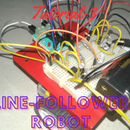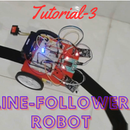Introduction: Ni-MH Battery Charger
Hello every one.....
Every one heard about SMPS. But how many know about its working??
SMPS is a wonder for me. So I am search much more about it. Now I know little bit about it. Here I am trying to introduce a small basic SMPS circuit. Here it is used for the charging of two Ni-MH cells. It is a single transistor SMPS. The heart of the circuit is the transistor. In this project the transistor fails multiple times. But at last the modified design works well. So take care. The circuit primary side work on 230V AC. It is dangerous for us. So take your own risk.
Let's start the project.!!!!
Step 1: Theory & Working
Theory
What is an SMPS ??? Everybody can give answer for this question. Because it is nothing but it is simply produce low voltage DC from a high voltage AC.
But there is an another problem. We know about the transformer DC power supply using the famous FULL BRIDGE RECTIFIER and many times we are use it. It produce the low voltage DC. So why we need SMPS. I done much more study to solve this question in my childhood. Then I find that the transformer is a linear device so its output voltage is change with input voltage variation. But SMPS is not a linear, so its output voltage is constant irrespective of the input voltage. It is it's main advantage. Other comparisons given below.
Transformer power supply
- Output voltage vary with input voltage variation
- High weight and size
- Unstable output voltage
- Less complex
Etc
SMPS
- Output voltage is always constant
- Low weight and size
- Stable output voltage
- Highly complex
- Etc
Working
In SMPS also use a transformer. But it is high frequency one because at high frequency the number of turns decreases so the size of the transformer decreases. So for producing high frequency we use a transistor and a winding in transformer for feedback for oscillator. Then the voltage at the primary varied using the PWM technology. That is, control the oscillator duty cycle for changing the average voltage. By this we get a fixed voltage at the output. SMPS block diagram representation given in the image.
Detailed explanation given at my blog. Please visit it.
https://0creativeengineering0.blogspot.com/2018/12/ni-mh-battery-charger-for-230v.html
Step 2: Circuit Design
The design steps are given below
- Design a rectifier to convert input AC voltage to DC for the working of the transistor.
- Select a transistor which withstand the high voltage and the frequency and the desirable current.
- Design a transistor biasing circuit.
- Design a feedback network to transistor for completing the oscillator
- Design a rectifier and filter at output
- Design a voltage indicator circuit for indicating battery full charge condition
Detailed design and circuit explanation are given in my blog. Please visit it.
https://0creativeengineering0.blogspot.com/2018/12/ni-mh-battery-charger-for-230v.html
Components
IC - TL431 (1)
Transistor - Mje 13001 (1)
Zener - 5v2 / 0.5w(1)
Diode - 1N4007 (2) , 1N4148 (3)
Capacitor - 2.2uF/50v (1) , 3.3nF (1) , 100pF/1Kv (1) , 220uF/18v (1)
Resistor - 1K (1) , 56E (1) , 79E (1) , 470K (1) , 2.7K (1) , 10E (1)
preset resistor - 100K (1)
LED - green (1) , red (1)
SMPS transformer (1) - from old mobile charger
All components are obtain from old PCBs, It is good, Because it is a recycling process. So you try all components from old PCBs. OK.
Detailed design and circuit explanation are given in my blog. Please visit it.
https://0creativeengineering0.blogspot.com/2018/12/ni-mh-battery-charger-for-230v.html
Step 3: Pcb Making
Here I made the circuit layout with out using any software. I draw the pcb design in a white paper. It done by several times of draw and redraw procedure to find the good positioning of each component. Then after completing this I copied it into the appropriate sizes PCB using a permanent marker. Then after drying the ink, I repeat the overdraw procedure several times to ensure good thickness of the mask for etching. Otherwise do not obtain a good PCB.
Step 4: Drilling of Holes
For drilling purpose I use a hand driller with a less than 0.5 mm drill bit. Which shown in in figure. Carefully make all holes with out damaging the PCB. Then redraw the layout one time to ensure the correct thickness of the mask. After this work clean the PCB to remove dust.
Step 5: Etching
For etching take the FeCl3 (ferric chloride) powder in a plastic box. Then add some water to it. Now it is seems like a reddish color. Then immerse the PCB in it by wearing a grouse in your hand. Then wait for a 20 min to dissolve the unwanted copper portion. If the copper do not dissolve fully wait for full dissolving action. After full dissolve process take the PCB from the solution and clean it by using clean water and remove the ink masking. For the whole process wear gloves.
Step 6: Soldering
Apply a small thickness solder to the whole PCB traces. It reduce the copper corrosion with the air. It will increase the PCB lifetime. For professional PCB's use solder masks. After this solder masking, solder the components in its position. The transformer place in soldering side of the PCB to save the PCB space. First place smaller components and then larger ones. After this, cut the unwanted leads of the components and clean the PCB using PCB cleaner (IPA solution).
Step 7: Testing
- First done the visual testing for any short circuit or cutting in PCB track.
- Then cross check the PCB and components with the circuit diagram.
- Using multi meter check any short circuit present in input side.
- After success of all testes connect the circuit to the 230V AC .
- Check the output voltages and set the preset to the position where the full charge voltage(2.4v) attains by using multi meters.
Finally We Done Our circuit. Hooo........
Step 8: Place the Circuit Inside a Cabin
Here I use a cover of old mobile phone charger. An old battery box is fitted in the charger to place the batteries. The finished image is given above. Drill the holes to place the led at the top side. Input wires are connected to the input pin of the charger.
Our simple SMPS battery charges is completed. It is work very well.
The full circuit explanation given in my blog. The link given below. Please visit it.
https://0creativeengineering0.blogspot.com/2018/12/ni-mh-battery-charger-for-230v.html





